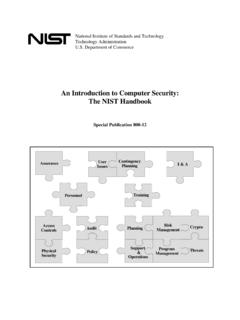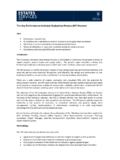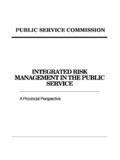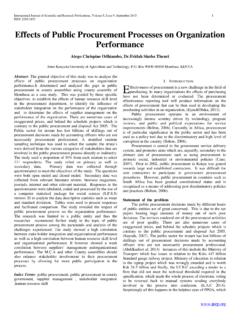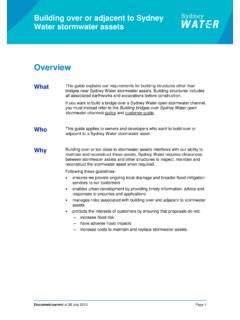Transcription of Good Public Policy Making: How Australia Fares
1 Agenda: a Journal of Policy Analysis and Reform, Volume 8, Number 1, 2000, pages 33-46 Good Public Policy making : How Australia Fares Richard Curtain l Gore (1999), called the prince of Policy wonks , has claimed that Industrial Age bureaucracies .. have grown far beyond the professional classes they were envisioned to be, and at times seem to specialise in immobility and apathy, lacking the leadership and also the freedom to change with the changing times. He argues that Public Policy is about showing leadership and responding to changed circumstances. He also infers that Public Policy is about setting broad directions. How does Australia rate in terms of Public Policy leadership and ability to set new Policy directions? The purpose of this paper is to identify the key elements of good Public Policy and to assess how well Australia s record stands against the identified criteria.
2 This exercise is not intended as detached analysis. It is a product of the author s own reflective practice as an independent Public Policy consultant over eight years. In particular, it draws on his involvement in three recent Public Policy exercises: the review of post compulsory education and training pathways in Victoria, the development of Policy options to address the barriers to training for older persons and a paper for the Dusseldorp Skills Forum comparing the operation of mutual obligation arrangements in Australia and the UK (Curtain, 1999). The paper uses, as its reference point, recent official statements on new Policy directions in the UK, Canada and New Zealand and highlights the reasons for the new directions. It presents an outline of what good Public Policy is, based on governmental reappraisals in these three countries.
3 Finally, it applies these criteria to assess three recent initiatives by the Commonwealth Government to develop new Policy . These initiatives are: the Youth Pathways Action Plan Taskforce, the employment aspects of the National Strategy for an Ageing Australia and the Reference Group on Welfare Reform (the McClure report). Particular attention is given to assessing the latter review as an exercise in good Public Policy making . This analysis indicates that there are clear signs that Public Policy making in Australia , compared with the countries cited above, is still deficient in a number of respects. Methods for identifying and analysing citizens needs are underdeveloped. This is reflected in the fact that the consultation processes involving the end users of the policies being formulated are often limited or Richard Curtain is a Melbourne-based consultant specialising in Public Policy research and analysis related to labour market and vocational education and training issues.
4 His e-mail address is: A34 Richard Curtain absent. Ways of offering citizens more scope to take the initiative in their dealings with publicly funded services are not canvassed. The paper concludes with some suggestions on ways to improve Australia s performance in Policy design and implementation. It is suggested that more independent sources of Policy advice need to be fostered with greater contestability in access to Public funding to facilitate this. Another way of improving Public formulation is for governments to find more varied ways of seeking input from a wider range of stakeholders, including a large cross section of ordinary citizens. Two ways to improve the environment for Policy innovation in Australia are Narrow Focus of Public Sector Reforms It is now acknowledged that Public sector reforms undertaken over the last decade around the world have been too narrow in their focus (Kettl, 2000).
5 There is an emerging consensus in the UK, Canada, US and New Zealand that the reforms have been mostly about internal restructuring to the detriment of good Public Policy making . The widespread use of the new structural arrangements based on the purchaser/provider split to achieve greater accountability for outcomes has often meant that other aspects of Public Policy have suffered. The March 1999 White Paper from the British Labour Government entitled Modernising Government makes this criticism forcefully. The White Paper notes that the management reforms of the last two decades have brought improved productivity, better value for money and, in many cases, better quality services. However, according to the White Paper (UK Government, 1999:11) these reforms have been achieved at the expense of broader issues that should be of concern to government.
6 Little attention was paid to the Policy process and the way it affects government's ability to meet the needs of the in general too little effort has gone into making sure that policies are devised and delivered in a consistent and effective way across institutional boundaries - for example between different government departments, and between central and local government. Issues like crime and social exclusion cannot be tackled on a departmental basis. An increasing separation between Policy and delivery has acted as a barrier to involving in Policy making those people who are responsible for delivering results in the front line. The Canadians also have identified a decline in Policy research capacity in their country ( Policy Research Initiative, 1999).
7 Policy issues and their interactions have become more complex. There is more overlap between issues and across jurisdictions, thus putting a premium on information sharing and on working across traditional Policy boundaries. Ever growing volumes of information, easier access Good Public Policy making : How Australia Fares 35 through technology and greater ranges of information introduced by more horizontal perspectives are challenging everyone's capacity to keep up-to-date. A Policy Research Initiative was created in July 1996 by the Canadian federal bureaucracy to strengthen the Policy capacity of government to deal with more complex Policy issues. An important second objective has been to foster wider participation from think tanks and academic institutions in the Policy making process (Deputy Minister Taskforces, 1996).
8 The Policy Research Initiative has been particularly successful in achieving the latter objective. Its second national conference held in 1999 attracted 750 participants from a cross section of Canadian society at $C600 per head. The Policy Research Initiative distributes over 7,000 newsletters and publishes a refereed journal. By 1999, its simple, low-cost web site had registered over 2 million hits from 17 countries (Curtain, 2000a). The problem of the narrow focus of Policy is recognised in New Zealand as well. The State Services Commission of New Zealand has published several studies identifying ways to improve departmental capability to contribute tos the strategic priorities setting (State Services Commission, 1999). Its recent report Essential Ingredients: Improving the Quality of Policy Advice (State Services Commission, 1999:8 and 14) highlights the prevailing short-term focus in Policy development as follows: the strongest impulses in the Public management system are towards action: Policy makers react to major problems, formulate quick solutions to them, take decisions, implement these and then move on to the next set of problems.
9 Policy development processes tend, therefore, not to easily accommodate inputs that are reflective or require long lead-times, such as longer-term research and evaluation. The particular gaps in the New Zealand Policy process identified ..are in areas of outcomes evaluation, issues identification (including anticipation of emerging problems), the notion of long-term and forward-looking research-based Policy analysis, Public consultation, and strategic analysis and management. Criteria for Good Public Policy making Public Policy making is first and foremost about determining objectives or societal goals (Encyclopaedia Britannica, 2000). These societal goals refer to big ticket issues such as the principles to underpin the conduct of foreign affairs, how to promote internal social cohesion, to how best to meet citizens needs during major life cycle changes.
10 It follows that Public Policy has to be effective (achieve its goals) and efficient (do so in a way that achieves the greatest possible benefit at the least possible cost). Goal setting in Public Policy needs to be long-term in perspective. 36 Richard Curtain This means starting with a comprehensive understanding of the current environment and defining what society s needs are in a way that an appropriate Policy response can address. It could, for example, involve developing likely futures scenarios in which a proposed Policy might need to operate. Good Public Policy also involves attention to process. This includes giving the end users ample opportunity to participate in a variety of ways. It also involves ensuring, for example, that the silo effect of departments operating independently of each other is minimised.
